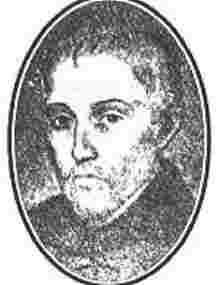Tomás Luis de Victoria
Tomás Luis de Victoria , also da Vittoria (* around 1548 in Sanchidrián , province of Ávila ( Spain ), † August 27, 1611 in Madrid ; Latin Thomas Ludovicus a Victoria Abulensis ) was a Spanish composer of the Renaissance .
He is considered one of the most important composers in Spain (alongside Francisco Guerrero and Cristóbal de Morales ). He wrote numerous vocal works for liturgical church music , including the famous Officium Sanctae Hebdomadae , a collection of sacred chants for Holy Week .
Life
Victoria was born the seventh child of Francisco Luis de Victoria and Francisca Suárez de la Concha. His father was a cloth merchant and died early. After that, Tomás was placed in the care of his uncle Juan Luis, who was a pastor near Ávila and provided the boy with a solid singing and schooling education in the cathedral of Ávila and the local Jesuit high school. Around 1565 Tomás went to Rome on a scholarship from King Philip II , where he graduated from the Collegium Germanicum , the Jesuit seminary . In 1571 he took over as moderator musicae the direction of the chapel of the Collegium as successor to Palestrina . Around 1585 Victoria published a collection of musical works in Rome, which also contains the Officium Sanctae Hebdomadae , and returned to Spain in the same year, where he was also the personal chaplain of the widowed Empress Maria, head of the chapel of the imperial monastery de las Descalzas Reales de Santa Clara (Convent of the Barefoot Clarissi ). There he wrote - according to his own wishes - only a few works, of which the Officium defunctorum published in 1605 is one of the best known. Victoria had composed it two years earlier on the occasion of the death of Empress Maria.
Tomás Luis de Victoria died in 1611 and he was the convent organist of the monastery to the end. The Vittoria Buttress cliff on Alexander I Island has been named after him since 1961 .
Musical creation
The musical work of Victoria can best be understood from his work as a priest and his deep power of faith, since, as befitted the spirit of the time, he composed exclusively for religious occasions. The Council of Trent (1545–1563) called for church music to be understandable and simple, and the young priest felt deeply committed to these decisions. Nevertheless, Victoria stands out among the composers of the Roman School as the one with the strongest expressive music.
See also: The reform of church music at the Council of Trent
The reason for the Officium Sanctae Hebdomadae is not exactly known. In contrast to numerous compositions by himself and his time (such as the Missa Papae Marcelli by Palestrina ), it was not dedicated to any living personality. The work contains 37 individual chants to the Tenebrae , which were to be sung ad matutinum , ie early in the morning , on the important days of Holy Week ( Palm Sunday , Maundy Thursday , Good Friday and Holy Saturday ) . They are one of the highlights of the polyphonic ( polyphonic ) Figuralgesangs the Renaissance . The Officium defunctorum, on the other hand, was created as a requiem for the late Empress, whose personal spiritual assistance Victoria had been since his return to Madrid. The composer edited this work as a revised version in the royal printing press in Madrid as the last publication. In addition, numerous masses and motets were created , including a Miserere . Like this, Victoria's Passions were part of the repertoire of the Sistine Chapel Choir and were performed there for over three hundred years.
Historical background
Victoria's lifetime was marked by the Reformation and Counter-Reformation as well as by numerous, sometimes violent, religious wars , fanaticism and an unbroken supremacy of the Church. The education of the composer himself corresponded to strict religiosity , because his seminary in Rome was conceived as a center of anti-reformatory forces. Victoria has created a synthesis of his personal beliefs and the applicable norms of church music. Concentrated and expressive, his work can still be regarded as the epitome of liturgical music.
literature
- Armin Raab: VICTORIA, Tomás Luis de. In: Biographisch-Bibliographisches Kirchenlexikon (BBKL). Volume 14, Bautz, Herzberg 1998, ISBN 3-88309-073-5 , Sp. 1576-1578.
Web links
- Works by and about Tomás Luis de Victoria in the catalog of the German National Library
- Works by and about Tomás Luis de Victoria in the German Digital Library
- Sheet music and audio files by Tomás Luis de Victoria in the International Music Score Library Project
- Sheet music in the public domain by Tomás Luis de Victoria in the Choral Public Domain Library - ChoralWiki (English)
- Cipoo.net sheet music (PDF and Midi)
- TomasLuisDeVictoria.org Sheet music (PDF, midi files, digitized original prints) and free recordings (Spanish / English)
- Umeå Akademiska Kör free recordings (Swedish / English)
- Tomás Luis de Victoria , in Cancioneros Musicales Españoles .
Individual evidence
- ↑ Die kleine Enzyklopädie , Encyclios-Verlag, Zurich, 1950, Volume 2, page 852
| personal data | |
|---|---|
| SURNAME | Victoria, Tomás Luis de |
| ALTERNATIVE NAMES | Thomas Ludovicus a Victoria Abulensis |
| BRIEF DESCRIPTION | Spanish composer |
| DATE OF BIRTH | around 1548 |
| PLACE OF BIRTH | Sanchidrián , Province of Avila (Castile) |
| DATE OF DEATH | August 27, 1611 |
| Place of death | Madrid |
